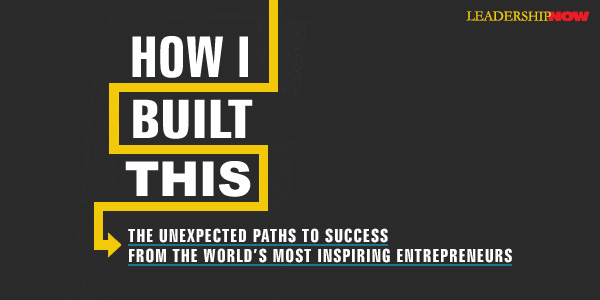How I Built This

TAKING AN IDEA and building it into something tangible. That’s the entrepreneurial journey. Guy Raz interviews innovators, entrepreneurs, and idealists to create a narrative of their journey from spark to movement in a highly successful podcast on NPR and now a book entitled, How I Built This.
How I Built This is an inspiring book that succeeds as a practical guide to the entrepreneurial journey.
After interviewing hundreds of founders and CEOs, Raz says they are just like you and me—human.
They all have sleepless nights and midnight terrors. Most of them, at some point, feel like imposters. They are not natural superheroes; they are all Clark Kents. The only difference between them and you, at this moment, is that when opportunity presented itself, they went into the phone booth and put on the cape. They took the leap.
Raz has taken the lessons from the shows and structured them to “follow the path we took as we traced their entrepreneurial hero’s journeys from the call to found their businesses, through the tests and trials of their growth phases, and finally to their destination as mature, global brands we know today.” His goal is to “pull back the curtain on entrepreneurship, to shed light on the black box of entrepreneurial success, and provide an architecture for how to think creatively about building something, whether that’s an idea, a movement, or, of course, a business.”
Embedded in these stories of entrepreneurs are business advice and life lessons. If the entrepreneurial journey does nothing else, it teaches you a lot about yourself. Here are some of those lessons:
The intersection of personal passion and problem solving is where good ideas are born and lasting businesses are built.
Passion is important but the trouble with passion by itself is that it can lead you down rabbit holes that only you care about, or to problems that only you have.
There are plenty of things that are scary but aren’t dangerous. And there are things that are dangerous but not scary. And those are the things that get you. Failing is scary. Wasting your life is dangerous. It’s mistaking fear for folly, risk for recklessness.
They knew their ideas would work because they knew their stuff.
The truth is that virtually no company is the creation of a single individual, but rather the product of a partnership, or even a group of co-founders.
The low points in a startup are so low that few could bear them alone.
Bootstrapping is about using other nonmonetary assets to solve problems that you would otherwise hire someone else to solve or throw money at—assets like your time, your effort, your network, and your own talent and ingenuity.
Really knowing your story—knowing the why—is often the bridge between founding and funding.
It’s a story that unearths the very reasons why the company exists, and sometimes even explains how both the company and the founder have managed to succeed for as long as they have.
If you don’t need to give up 5, 10, 20 percent of your company before you are even sure what it’s going to look like, to people who will never care about it as much as you and your partners do, then you shouldn’t take this money.
There is only one reliable way to engineer word of mouth: you have to make a really good product. Actually, that’s not precisely true. It can’t just be really good. It has to be so good that someone has to recommend it.
All of them have done whatever it takes to stay alive, to make it another day, to get their product on the shelves, to get customers in the door, to get vendors paid, to get investors to write checks. All in the hope that, as they stand on the balcony and survey the dance floor below, whatever they realize they have to do today, or they might have to do tomorrow, is that one steady pull more that will finally get them out and through.
First Andreessen Horowitz told him, “what usually look like good ideas are bad ideas, and what look like bad ideas are good ideas, because the problem with good ideas is that everyone tries to do them, and as a result, there is no value to be created there.” Second, he said, “you need to do the thing that you believe you are the best person in the world to do, where you have a unique proposition, given your story, to solve a problem.”
More than just stoking the flames of a fighting spirit when things aren’t going your way, the mission is what gives your business, and you, direction.
The point is, you can do everything right, you can make all the plays, and still can lose the game. The cards are generally stacked against anyone thinking about starting a business. And yet, at the same time, if one or two bounces go your way, all of a sudden you can come out of the game as the big winner. That is luck.
The one thing Raz has learned from all of the people he has interviewed is this:
Be kind; that kind leaders have kind companies; that kindness is a powerful tool; that kindness is free—it costs nothing!—and that return on investment for kindness is bigger than that for any financial investment an entrepreneur can make.
As the stories in this book unfold, you will see that all entrepreneurs are good at dealing with rejection. The entrepreneurial journey is fill with “no.” It is their curiosity that often saved them and got them moving again.
Starting a business is never easy, but if you have, or if you are thinking about doing it, you need to read this book. (And don’t forget to read the Afterword. It’s inspiring and helpful.)
* * *

Like us on
Instagram and
Facebook for additional leadership and personal development ideas.
* * *




Posted by Michael McKinney at 07:45 AM
Permalink
| Comments (0)
| This post is about Entrepreneurship










